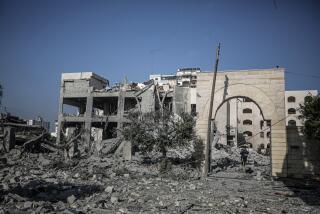Bush Library Team Plays First Inning in Bowling Alley : History: Yale baseball glove, gifts from foreign governments, documents, and old furniture from the ex-president’s childhood are included. Officials are preparing for museum’s opening in 1997.
- Share via
COLLEGE STATION, Tex. — The stuff of George Bush’s life--an old infielder’s mitt, the door of a Kuwaiti palace, even a huge likeness of Bush’s head from a Republican convention--is being sorted in an old bowling alley.
Of course, there’s not enough room in the old Chimney Hill Bowl for 36 million pages of documents, a million photos and 40,000 objects. So some of it is crammed next door, in what used to be the kitchen of a Chinese restaurant.
Someday, this will be the treasure of the George Bush Presidential Library and Museum at Texas A&M; University. But for now, it’s just pile upon pile of Bush fodder for the archivists.
“Our job is to preserve, arrange and review and ultimately try to make as much available as we can to the American people,’ said David Alsobrook, acting director of the Bush Presidential Materials Project.
The actual library and museum--an $83-million project--is about 90% complete on an engineer’s drawing board. Groundbreaking is planned for November with dedication in 1997.
That means Alsobrook and his staff of 10 researchers from the National Archives have three years to catalogue and organize items that filled four C-5A cargo planes in the days just before Bush vacated the White House in 1993.
The material isn’t confined to Bush’s presidency. Other items come from his eight years as vice president, his tenure as a Texas congressman, as CIA director and other government stops that accounted for dozens of moves his family made around the globe.
They even include scarred furniture that made many of the moves and date back to home movies of Bush as a child. The museum also has the left-handed first baseman’s glove Bush used at Yale. “BUSH,” prominent in capital block letters, was carved into the leather decades ago.
Material from all over the world continues to arrive as foreign governments and ordinary citizens deliver gifts and Bush memorabilia.
“This is not a static collection. It’s forever growing,” said Patricia Burchfield, the museum curator. “Every day is like Christmas around here. There’s some really spectacular things.”
A gold model of a Saudi palace. Gold swords and jewelry from grateful Saudis and Kuwaitis for Bush’s role in the Gulf War. A saddle from Mexico. At least two golf bags and sets of clubs. A porcelain candelabra from Germany. A section of the Berlin Wall.
One Oklahoman who served in Desert Storm sent a piece of marble column he said came from Saddam Hussein’s summer palace in northern Iraq. An emir from Kuwait sent Bush a door from his palace, trimmed with gold and engraved with the names of American soldiers killed during the Persian Gulf War.
“What you’re looking at here is very recent American history,” said Alsobrook, who spent 10 years at the Carter Presidential Library in Georgia before drawing the Bush assignment.
Uniformed guards patrol the premises. There are closed-circuit television monitors and sophisticated electronic detectors along walls and doors. Some printed material is classified and will remain so for years; it is open only to those with top-secret clearances.
There are also rows of shelves holding campaign signs, banners and buttons. “We’ve got every piece of important campaign memorabilia that deals with George Bush,” said Burchfield, who spent 20 years at the Lyndon Johnson Library in Austin.
A warehouse-like room where bowlers once racked up strikes now has 58 lanes of stacked shelves filled with boxes of printed documents.
“You just take little bites,” Alsobrook said.
While Alsobrook and his staff try to organize the collection, Don Wilson is charged with finding a way to pay for the three-building complex on a 90-acre site at the west end of campus, across from the goat and sheep center.
The museum and library will be the centerpiece of the Center for Presidential Studies, the Center for Public Leadership Studies, the Center for International Studies, the George Bush School of Government and Public Service and several Texas A&M; academic departments.
The university has committed $41 million. Wilson, executive director of the Bush Presidential Library Foundation and former director of the Gerald Ford Library, has raised about half of the $42 million he needs. He expects to complete the fund raising in a year.
“We’re in good shape,” he said. “It’s not a tough sell.”
Bush has insisted it be a working place for historians and students.
“He’s a little bit self-conscious and really doesn’t want this to be a monument,” Wilson said. “But he’s pretty comfortable with it and very interested because he wants to spend a lot of time here.”
Computerization of written documents is making the job of sorting documents somewhat easier. Historians eventually will be able to use key words or phrases to find what Bush said about a particular subject and when he said it.
For example, historians will note that in 6,786 speeches or public statements, Bush mentioned his least favorite vegetable--broccoli--54 times.
More to Read
Sign up for Essential California
The most important California stories and recommendations in your inbox every morning.
You may occasionally receive promotional content from the Los Angeles Times.










